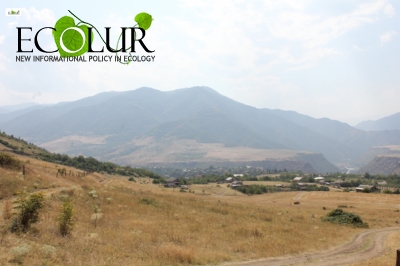

EcoLur
“Teghut” CJSC, which develops Teghut copper and molybdenum mine in Lori Region, reports about carrying out forest plantation versus felled down forest in the area of 67 ha. Around 7 ha of forest should have been planted in Shnogh Village, which is under the immediate impact of Shnogh project. The working group in the frames of ENPI EAST FLEG 2 visited Shnogh Village and the area of forest plantation. The first nursery plants were planted in the spring of 2009, i.e. over 6 years ago. Afterwards the territory was planted several times again. The photo clearly shows there is no young forest or at least growing plants. There are around 2 dozens of nursery plant in the whole territory, which turn out to be near water, as the water is missing in the rest area. You can see no irrigation and proper care have been provided, which is a necessary and costly part of forest plantation program. Shnogh villagers were opposing to this program, as they lost 7 ha of agricultural land areas, besides the land areas alienated from them for Teghut project.
Reminder: “Teghut” CJSC is obliged to plant 714 ha of forest instead of felled down 357 ha in Lalvar forest, where Teghut program is implemented.
Here is the recording from the meeting on forest problems in Shnogh Village with the participation of Shnogh Village Head Hovik Sahakyan and representatives of Lalvar forestry enterprise.
Hovik Sahakyan: “It’s a serious problem. It was supposed that “Teghut” CJSC should have given priority to Shnogh and Teghut villages for forest plantation in 714 ha. But we don’t have that much area. All land areas have been privatized or are used for pastures. We have agreed to give them 17 ha – 7 ha from Shnogh Village and 10 ha from Teghut. Meanwhile we had to face the resistance of the villagers, who didn’t agree to give away their land areas. And then we said it’s better to plant orchards and not forests, what’s the difference? They planted 13 ha of orchards for us, where they planted nectarine, nuts and hazelnuts according to the land owners’ wish.”
Nazeli Vardanyan, an environmental lawyer: “The difference is huge. Forest is an ecosystem, while an orchard is not. The law says they have to plant forest: this is how forest is destroyed.”
Hovik Sahakyan: “Yes, but anyway we can’t get a forest because of monocultures the area is planted with. They plant whatever they manage to get. What’s our benefit if they plant a forest, for example, in Sisian. We, our nature and forest have incurred damage. All the production part is located in the area of Shnogh village. 347 households in Shnogh Vilage have been taken away they land areas.”
EcoLur: How many people are employed in Teghut?
Hovik Sahakyan: 253.
Nazeli Vardanyan: Why don’t you make the area a community forest?
Hovik Sahakyan: Forest can’t grow in this area, as it has no water and nobody takes care of the area. The plant survival is almost zero.
EcoLur: What about free-of-charge 8 cubic meters?
Lalvar Forestry Officer: There are families, which use much more wood and they are entitled to buy more at set minimum prices – 1000-2000 AMD for one cubic meter.
EcoLur: What about water? How do you solve this problem?
Hovik Sahakyan: Now we even take water from the springs located above the territory, but we can experience problems in future. We have received complaints from the residents in regard with the tailing dump, where leaks occur and the polluted water flows into the orchards of some villagers. I would like to add that forest sector needs reforms: the people employed in the forest are deprived on uniforms, transportation, defense means and get low salary. Besides, they don’t enjoy any rights. The Community also doesn’t take part in any discussion. It turned out that “Teghut” CJSC also carried out forest plantation in Odzun and Yeghegnut villages, Lori Region.
To be continued.
 |
 |
 |
 |
 |
September 03, 2015 at 13:54
